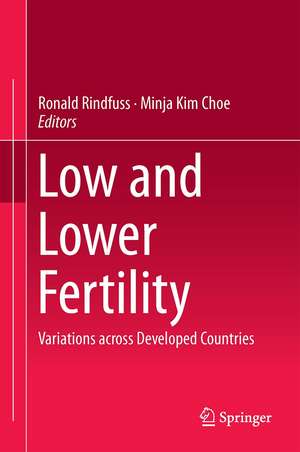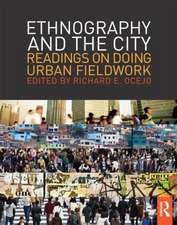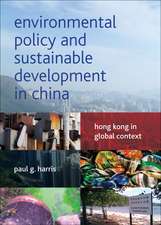Low and Lower Fertility: Variations across Developed Countries
Editat de Ronald R. Rindfuss, Minja Kim Choeen Limba Engleză Hardback – 19 oct 2015
| Toate formatele și edițiile | Preț | Express |
|---|---|---|
| Paperback (1) | 382.57 lei 6-8 săpt. | |
| Springer International Publishing – 23 aug 2016 | 382.57 lei 6-8 săpt. | |
| Hardback (1) | 389.70 lei 6-8 săpt. | |
| Springer International Publishing – 19 oct 2015 | 389.70 lei 6-8 săpt. |
Preț: 389.70 lei
Nou
Puncte Express: 585
Preț estimativ în valută:
74.59€ • 76.87$ • 62.97£
74.59€ • 76.87$ • 62.97£
Carte tipărită la comandă
Livrare economică 03-17 martie
Preluare comenzi: 021 569.72.76
Specificații
ISBN-13: 9783319214818
ISBN-10: 3319214810
Pagini: 188
Ilustrații: VII, 188 p.
Dimensiuni: 155 x 235 x 17 mm
Greutate: 0.45 kg
Ediția:1st ed. 2015
Editura: Springer International Publishing
Colecția Springer
Locul publicării:Cham, Switzerland
ISBN-10: 3319214810
Pagini: 188
Ilustrații: VII, 188 p.
Dimensiuni: 155 x 235 x 17 mm
Greutate: 0.45 kg
Ediția:1st ed. 2015
Editura: Springer International Publishing
Colecția Springer
Locul publicării:Cham, Switzerland
Public țintă
ResearchCuprins
1. Introduction and overview. Minja Kim Choe and Ronald R Rindfuss.- 2. The Surprise that Ought Not To Be: Sustained Low Fertility and Slow Policy Response in China. Wang Feng (University of California – Irvine and Fudan University, Shanghai).- 3. Singapore’s Pro-Natalist Policies: To What Extent Have They Worked? Gavin Jones (Nationa University of Singapore).- 4. Policy Responses to a Rapidly Ageing Population: Hong Kong, SAR. Stuart Basten (University of Oxford).- 5. Below-Replacement Fertility in Japan: Patterns, Factors and Policy Implications. Noriko O. Tsuya (Keio University).- 6. Low Fertility, Population Ageing, and Policy Response in South Korea. So-Young Lee (KIHASA).- 7. Variation in U.S. Fertility: Lowest-low and the Not-so-low. S. Philip Morgan (University of North Carolina).- 8. The Evolution of Population and Family Policy in Australia. Peter McDonald (The Australian National University).- 9. Policy Responses to Low Fertility and Population Ageing: The Case of the Netherlands. Melinda C. Mills (University of Groningen, moving June 2014 to Oxford University).
Notă biografică
Ronald R. Rindfuss is a Research Professor in the Department of Sociology, Adjunct Professor in the Geography Department, and a Fellow of the Carolina Population Center at the University of North Carolina – Chapel Hill, and a Senior Fellow at the East-West Center, Honolulu, HI. He is Past President of the Population Association of America and a former Director of the Carolina Population Center. His research interests include fertility, population and the environment, migration and family demography.
Textul de pe ultima copertă
This volume examines two distinct low fertility scenarios that have emerged in economically advanced countries since the turn of the 20th century: one in which fertility is at or near replacement-level and the other where fertility is well below replacement. It explores the way various institutions, histories and cultures influence fertility in a diverse range of countries in Asia, Europe, North America and Australia. The book features invited papers from the Conference on Low Fertility, Population Aging and Population Policy, held December 2013 and co-sponsored by the East-West Center and the Korea Institute for Health and Social Affairs (KIHASA). It first presents an overview of the demographic and policy implications of the two low fertility scenarios. Next, the book explores five countries currently experiencing low fertility rates: China, Hong Kong, Japan, Singapore and South Korea. It then examines three countries that have close to replacement-level fertility: Australia, the Netherlands and the United States. Each country is featured in a separate chapter written by a demographer with expert knowledge in the area. Very low fertility is linked to a number of conditions countries face, including a declining population size. At the same time, low fertility, and its effect on the age structure, threatens social welfare policies. This book goes beyond the technical to examine the core institutional, policy and cultural factors behind this increasingly important issue.It helps readers to make cross-country comparisons and gain insight into how diverse institutions, policies and culture shape fertility levels and patterns.
Caracteristici
Examines two distinct low fertility scenarios that have emerged in economically advanced countries since the turn of the 20th century Explores how a country’s institutions, policies and culture shape its fertility level and pattern Leading demographers compare fertility influences across high-income, highly-educated countries with advanced economies Highlights the unique case of China which raises important questions about the importance of policy versus social and economic factors

















